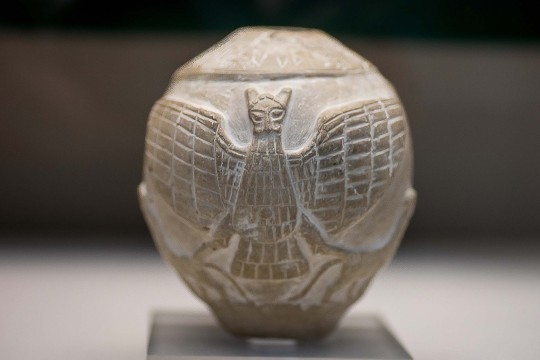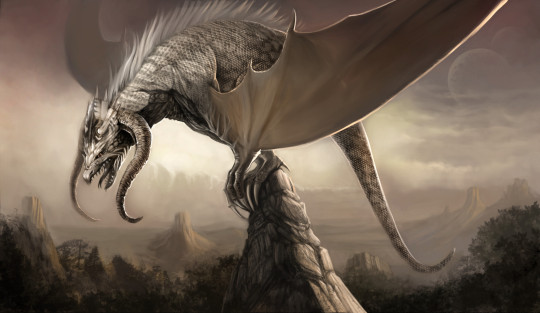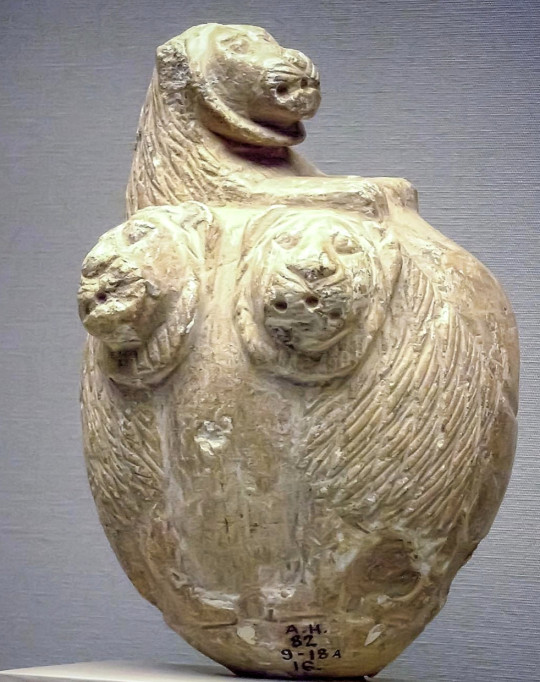#Ninurta's Exploits
Text

Asag doesn't really have a physical description in Ninurta's Exploits, so I took a little liberty with the little information given: his parentage, the mountain's allegiance to him, and how his remains are apparently now simply stones.
#BriefBestiary#bestiary#digital art#fantasy#folklore#legend#myth#mythology#asag#azag#sumerian mythology#ninurta#ninurta's exploits#lugal-e#monster
16 notes
·
View notes
Text
Sharur
Sharur (Car-ur) was the magical battle-mace of Ninurta, the Mesopotamian warrior god of winds and storms. As an animated mythological weapon, Sharur served as a fierce protector as well as a trusted advisor, messenger and spy. The battle-mace played an important role in the late third millennium BCE Sumerian Exploits of Ninurta, gathering military intelligence, relaying communication to and from…

View On WordPress
2 notes
·
View notes
Photo


Sumerian Mythology - The earliest deities of ancient Mesopotamia (58)
Angim - The second part of the exploits of Lord Ninurta, Lugal-e
The myth Angim (=an-gim dím-ma: Sumerian for 'made like the god An:Ref) is directly linked to the preceding tale (Lugal e: Ref2) and describes the triumphant return of Ninurta from his victorious campaign against the Kur. This document can be considered as the second part of the deeds of the god Ninurta, which are recorded in the myth Lugal-e. This story begins with a hymn to the hero, who resumes his position in the Sumerian pantheon, and his exploits in the Kur. The mere list of the trophies brought back from the Kur makes one realise that Ninurta engaged in combat with truly superhuman creatures.
The narrative relates that he mounts the monsters, “slain heroes,” he has defeated as trophies on his “shining chariot.” Echoing the number of Tiāmat’s eleven monstrous offspring [Ref3], (from the Enûma Eliš, whom Marduk [Ref4] had vanquished), Ninurta’s conquests included:
wild bulls he hung on the axle,
captured cows on the cross-piece of the yoke,
a six-headed Wild Ram on the dustguard,
Bašmu (Sumerian: Usum: the warrior dragon) on the seat,
The Magilum Boat (a ship of the netherworld), or "ship-locust," on the frame,
the bison Kusarikku (Sumerian: gud.alim) on the beam,
the mermaid Kulianna on the footboard,
“white substance” (gaṣṣa, gypsum), on the forward part of the yoke,
strong copper on the inside pole pin,
the Anzu-bird on the front guard
And the seven-headed serpent possibly Mušmaḫḫū on another illegible part.

シュメール神話~古代メソポタミア最古の神々(58)
アンギン神話〜『ルガル・エ;ニヌルタ神の功績』の第二部
アンギン神話(=アンギン ディンマ:シュメール語で『アン神(参照)の如くつくられた』の意味)のは、前の物語(ルガル・エ:参照2)に直結しており、ニヌルタがクル族との戦いに勝利して凱旋する様子を描いている。その内容から『ニヌルタ神のニップル市への凱旋』とも呼ばれている。この物語は、シュメールのパンテオンでの地位を回復した英雄への賛歌と、クルでの彼の活躍から始まる。そして、神話「ルガル・エ」に記されたニヌルタ神の功績の第二部と考えられている。
クルから持ち帰った戦利品のリストを見るだけでも、ニヌルタが本当に超人的な生き物と戦ったことがわかる。
物語によると、彼は倒した怪物たち「殺された英雄」をトロフィーとして「輝く馬車」に乗せた。マルドゥク(参照4)が征服したエヌマ・エリシュから生まれたティアマトの11の怪物(参照3)の子孫の数と同じように、ニヌルタの征服したものは以下の通りである:
野生の雄牛を車軸に吊るした。
くびきのクロスピースには捕らえられた牛たち。
ダストガードには6つの頭を持つ野生の雄羊。
座面にはバシュム(シュメール語でウシュム:戦士の竜)が描かれている。
フレームにはマギラム・ボート(冥界の船)又は(船底の木)。
梁にはバイソン属のクサリク(牡牛人間)。
足板には人魚のクリアンナが乗っていた。
くさびの前方部分には「白い物質」(白亜、石膏)。
内側のポールピンには強い銅。
前衛にはアンズー鳥、
そしてまた、読めない部分には七頭のムシュマッヘが描かれてる。
#angim#ninurta#lugal e#Ninurta's Exploits#superhuman creatures#sumerian mythology#sumerian gods#mythology#legend#folklore#nature#art
70 notes
·
View notes
Photo

Sumerian Mythology - The earliest deities of ancient Mesopotamia (57)
The Ninurta Myths ’Lugal-e’ – Sharur / The weapon in humanised form Ninurta's favourite
Sharur, which means "smasher of thousands" is the weapon and symbol of the god Ninurta. It is an enchanted talking mace.
Sharur plays a prominent role in an incident in which Ninurta is described as using it to defeat Asag, a monstrous demon; Sharur has the power to fly across vast distances without impediment and communicate with its wielder.
This myth receives its most complete treatment in the epic Lugal-e (Ref1), which in English is rendered as "The Exploits of Ninurta (O King)". According to this text, Sharur's role in the battle is not only as a weapon. It provides crucial intelligence to the hero, acting as an emissary between the god Enlil and Ninurta and relating to him the former's will, including a strategy to defeat Asag, the evil spirit of the mountains. Kur (Underworld: Ref2) is associated with mountains and the primordial elements.
Apart from its aforementioned ability to fly and communicate with its wielder, Sharur may also take the form of a winged lion, a common motif in Sumerian and Akkadian lore.

シュメール神話~古代メソポタミア最古の神々(57)
ニヌルタの神話 「ルガル・エ」〜シャルウル/ニヌルタ愛用の人格化した武器
シャルウルとは、「千人切り」という意味で、ニヌルタ神の武器でありシンボルで、魔法をかけられた話す鎚矛(つちほこ)である。
シャルウルは、ニヌルタが山の悪魔アサグを倒す場面で使用したとされ、重要な役割を果たしている。また、シャルウルには広大な距離を支障なく飛行し、使用者と交信する力がある。
この神話が最も完全な形で描かれているのは、「ルガル・エ(参照1)」という叙事詩で、英語では「ニヌルタの功績 (王よ)」と訳されている。この文献によると、戦いにおけるシャルウルの役割は武器としてだけではない。エンリル神とニヌルタの間を取り持ち、エンリル神の意志を伝え、アサグを倒すための戦略など、主人公に重要な情報を提供するのである。クル(冥界:参照2)は山や原初の要素と結びついている。
前述のように空を飛び、使い手と会話する能力を持つほか、シュメールやアッカドの伝承でよく見られる翼のあるライオンの形をしていることもある。
#sharur#mace#ninurta#lugal e#Ninurta's Exploits#o king#sumerian mythology#sumerian gods#mythology#folklore#legend#kur#underworld#zagros mountain#mace head#nature#art
68 notes
·
View notes
Photo

Sumerian Mythology - The earliest deities of ancient Mesopotamia (55)
The Ninurta Myths Lugal-e - The longest Sumerian epic
It is one of the longest works ever written in Sumerian, with 726 lines in full.
The title Lugal-e means "O king!" and comes from the poem opening phrase in the original Sumerian. In this case, Rugal (king) refers to the god Ninurta (Ref). Ninurta's Exploits is a modern title assigned to it by scholars. The poem was eventually translated into Akkadian after Sumerian became regarded as too difficult to understand, around the time of the reign of King Gudea (22nd century BCE).
Second only to the goddess Inanna, Ninurta probably appears in more myths than any other Mesopotamian deity.
The ancient Mesopotamian myth beginning Lugal-e ud me-lám-bi nir-ğál (=Sumerian for 'Storm of King Melam, the incomparable god Ninurta'), also known as Ninurta's Exploits.
The great epic consists of three parts: the first part, which is an epic telling of the warrior-god and god of spring thundershowers and floods, his deeds, waging war against his mountain rival á-sàg (“Disorder”; Akkadian: Asakku), the second part tells how Ninurta then used the defeated stones to build mountains as restoration of the flow of the Tigris and Euphrates rivers for irrigation and agriculture; finally, Ninurta returns to Nippur from war in his “beloved barge” Ma-kar-nunta-ea and afterward judging his defeated enemies, determining the character as well as use of "the army of rock demon offsprings", and is celebrated as a hero in the third part.
This myth combines Ninurta's role as a warrior deity with his role as an agricultural deity. It is a major bilingual epic dating from the second half of the third millennium BCE.

シュメール神話~古代メソポタミア最古の神々(55)
ニヌルタの神話 ルガル・エ〜シュメール最長の叙事詩
『ルガル・エ』は全文で726行にもなる、シュメール語で書かれた最も長い作品の一つである。タイトルの『ルガル・エ』は「王よ!」という意味で、原文シュメール語の詩の冒頭のフレーズに由来する。この場合、ルガル(王)とはニヌルタ神(参照)のことである。『ニヌルタの功績』というタイトルは、学者たちがつけた現代的なものである。この叙情詩は、シュメール語が難解とされたため、グデア王時代(前22世紀)の頃、最終的にアッカド語に翻訳された。
女神イナンナに次いで、ニヌルタはメソポタミアの他の神々よりも多くの神話に登場する。
古代メソポタミアの神話「ルガル ウ メラム・ビ ニルガル(=シュメール語で「メラム王の嵐、比類なき神ニヌルタ」の意)」は、「ニヌルタの功績」とも呼ばれている。春の雷雨や洪水を司る戦士の神であるニヌルタの、山のライバルである悪霊アサグ(「無秩序」の意;アッカド語:アサック)との戦いを描いた第一部、その後、ニヌルタは世界を整理し、倒した戦士たちの石を使って山を築き、小川や湖、川がすべてチグリス川やユーフラテス川に流れ込み、灌漑や農業に役立つように設計する経緯を語る第二部、その後、敗れた敵「石の戦士の軍隊」を裁き、石の特徴と用途を決めた。最後に、ニヌルタは「最愛の船」マカルヌエンタエダに乗って戦地からニップールに帰り、英雄��して祝福される第三部と、物語は三部作で構成されている。この神話は、ニヌルタの戦士神としての役割と、農耕神としての役割を組み合わせたもので、紀元前3千年紀の後半に作られたバイリンガルの大叙事詩である。
#lugal e#ninurta#Ninurta's Exploits#o king#Lugal-e ud me-lám-bi nir-ğál#asag#tigris and euphrates rivers#the stone warriors#sumerian mythology#sumerian gods#mythology#folklore#legend#nature#art
87 notes
·
View notes